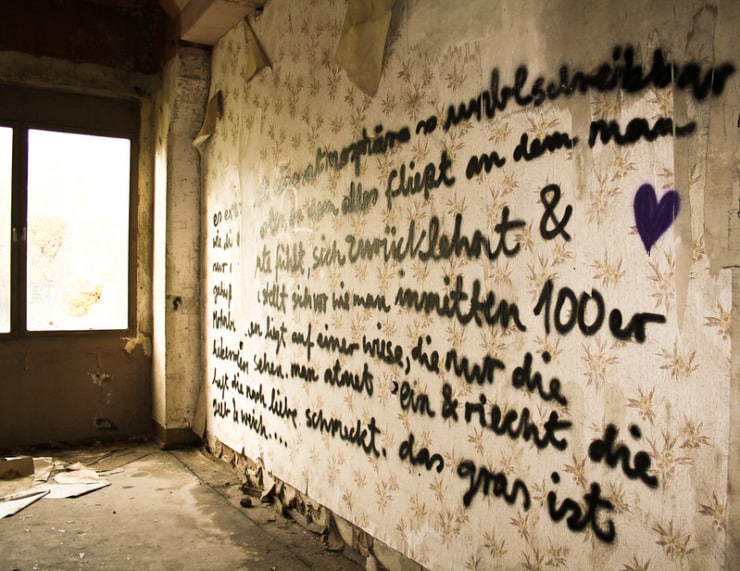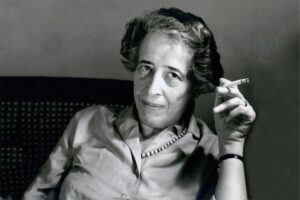
Did you know that Hannah Arendt also wrote poetry?
Hannah Arendt (1906-1975) is perhaps best remembered today as the political scientist and philosopher who studied Hitler’s Germany and other totalitarian regimes and described “the banality of evil.” Born in Germany, she earned a Ph.D. from Marburg University, but was forced to flee to Paris when the Nazis rose to power. She and her husband, Heinrich Blucher, fled Paris after the fall of France and eventually settled in New York City.
She became the research director for the Council on Jewish Relations, editor of Schocken Books, and executive director of Jewish Cultural Reconstruction, described by Encyclopedia Britannica as created to “salvage Jewish writings dispersed by the Nazis.” Later, she taught at the University of Chicago and the New School of Social Research in New York.

Hannah Arendt
Her influence expanded with publication of Origins of Totalitarianism (1951), The Human Condition (1958), and Eichmann in Jerusalem (1963). The book on Eichmann was highly controversial, depicting him not as evil or monstrous but more of a thoughtless bureaucrat; it was this book that introduced the phrase “banality of evil.” She published several other books, but these three made her reputation.
Arendt often said that the language of poetry often informed her work, but only a tiny handful of people knew she wrote poetry. In 2011, Arendt scholar and translator Samantha Rose Hill found 70 poems written by Arendt in the archives of the Library of Congress. Working with translator, scholar, and essayist Genese Grill, Hill has published the poems as What Remains: The Collected Poems of Hannah Arendt.
Presented chronologically in both German and English, the poems extend from 1923 to 1962, with a gap between 1926 and 1941. Hill doesn’t offer an explanation, other than to say no record of poems exists, and Arendt spent nine years in Paris in the 1930s helping Jewish youth escape Germany to Palestine. It may be that any poems she may have written during this period were left behind when she and her husband fled Paris, but no one really knows.
Most of the poems are untitled and short. She wrote simply and movingly; the poems often reflect an intensity of feeling and emotion. This poem was written in the late 1950s:
Intense Tenderness

in the palms of our hands,
when the skin itself
befriends foreign forms.
Tenderness is
in the arched night sky,
when the distance itself
comes to know the earth.
Tenderness is
in your hand and mine,
when the nearness soon
captures us.
Melancholy is
in your gaze and mine,
when the intensity between us
draws us into one another.
We know from her writings and notes that Arendt was familiar with German poets like Goethe, Schiller and Rainer Maria Rilke. She also read Emily Dickinson, William Wordsworth and W.H. Auden. She became friends with both Auden and poet Robert Lowell, and she met Langston Hughes, e.e. cummings, and Elizabeth Bishop, among others. Many of her published works drew upon the language of poems and the poetry she read.

Samantha Rose Hill

Genese Grill
Samantha Rose Hill has written the biography Critical Lives: Hannah Arendt and is currently working on a book on loneliness for Yale University Press. Her essays have been published in numerous scholarly and literary journals. Genese Grill is a translator, essayist and scholar on the work of the Austrian writer Robert Musil.
In many ways, What Remains is a historical artifact, a largely personal treasury of poems written between the period of the Weimar Republic in Germany and the Cold War. The poems were written by a philosopher and intellectual largely known for her work on totalitarianism, and someone who experienced the boot heel of the Nazi regime on repeated occasions. And yet, tucked away in notebooks stored in archives, her poetic spirit endured and remained.
Photo by Sebastian Raskop, Creative Commons, via Flickr. Post by Glynn Young.
How to Read a Poem uses images like the mouse, the hive, the switch (from the Billy Collins poem)—to guide readers into new ways of understanding poems. Anthology included.
“I require all our incoming poetry students—in the MFA I direct—to buy and read this book.”
—Jeanetta Calhoun Mish
- Poets and Poems: Christine Rhein and “Wild Flight” - October 16, 2025
- Poets and Poems: Peter Murphy and “You Too Were Once on Fire” - October 14, 2025
- “Your Accent! You Can’t Be from New Orleans!” - October 9, 2025

Sandra Heska King says
“Tenderness is
in the palms of our hands,
when the skin itself
befriends foreign forms.”
I love that verse. Also, this was a new name to me. But then I always learn something new from your words. 🙂